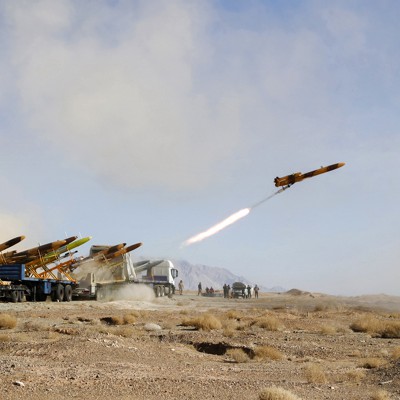U.S. officials recently announced that they are considering sanctions against a supply chain that enables Iran’s unmanned aerial systems, or UAS, program. But sanctions are unlikely to be effective, and in fact, are almost beside the point. What is needed is a multilateral effort around ending Iran’s support of militias acting against internationally recognized governments.
The closer look at UAS-directed sanctions is in part the Biden administration acting on its promise to help Saudi Arabia ward off rockets and drones fired from Houthi rebel positions on the Yemeni border. It is also an attempt to protect U.S. forces from increasingly sophisticated drone attacks by Islamic Revolutionary Guard Corps proteges in Iraq.
U.S. options are limited. Section 164 of the 2021 National Defense Authorization Act directs the Defense Department to “prioritize the objective of developing and executing a plan to develop, test, and begin production of” systems to defeat Group 1-3 unmanned platforms. And on June 27, the U.S. military struck a drone production facility on the Iraq/Syria border operated by two Popular Mobilization Units in Iraq.
But sanctions may not be able to affect Iran’s program in a way that improves security for local populations or U.S. citizens or military personnel working and living in the Middle East. Iran procures drone components from multiple sources. Some parts are predominantly produced for commercial and recreational users, which explains why they are not already sanctioned. “The IRGC uses German made 3W Modellmoterin engines in some of their cruise drones,” says Archie Stafford, a UAS specialist for the Academy of Model Aeronautics, the largest recreational modeling organization in the United States. “I imagine Germany would be angry if we started sanctioning their recreational aircraft industry.” The drone that attacked the Department of State-operated Baghdad Diplomatic Support Center on June 9 was built cheaply with entirely off-the-shelf components, including a motor made in Japan and an inexpensive commercial Global Navigation Satellite System antenna with a built-in compass. Other parts come from black-market salvagers of drone test and attack debris, who would not be affected by sanctions.
Nor does cutting off Iran’s access to dollar-based financial markets hold much promise. Tehran can, for example, sell oil to China in exchange for critical drone parts. Another option is to sell oil for yuan using a mechanism offered by Kunlun Bank, then turn around and buy drone parts with yuan.
And technology advances may soon free Iran of the need to import any drone parts at all. Iran has developed expertise in 3D-printing many of their own parts and in teaching Houthi and Hezbollah operatives in Yemen, Lebanon, and Syria to do the same, running what we’d call a train-the-trainer program for this purpose. According to analysts who read dark-web discussions about drone design, Iran debuted a turbine engine on an unmanned platform before the U.S. government believed such an engine was within their reach.
While Iran continues to accelerate technological advancement, the looming concern is about payload. Right now, the lethality of the drones provided by the IRGC to its affiliates is limited by the size of the payload an airframe can carry. The Mohajer-6 model provided by the IRGC to PMUs in Iraq, for example, can carry a 40kg payload, and this threshold is continually being raised. Iran has latched cameras and explosives to its arsenal of drones but thus far has not crossed the nightmarish Rubicon into chem/bio. Any actor anywhere choosing to use unmanned systems to disperse chemical or biological agents would spike the level of threat posed by drones globally.
The U.S. and the international community would not have a problem with Iran developing increasingly sophisticated drones reserved for its defense. The problem lies in Iran’s policy of distributing these drones to rogue militias outside of its borders for the purpose of destabilizing areas of the region that do not support establishing Vichy governments loyal to Tehran. No other nation subscribes to this foreign policy. Iran continues this policy not only because it is effective but because it is tolerated.
What is needed is a multilateral effort around ending Iran’s support of militias acting against internationally recognized governments. This should not be difficult to build. World powers and nations in Iran’s neighborhood are united in opposition to Iran’s export of drones to groups like Hezbollah, the PMUs in Iraq, and the Houthis in Yemen. This opposition should be coalesced and activated.
A starting point for this action could be extending the Missile Technology Control Regime, or MTCR, guidelines that prohibit member states from exporting certain weaponized drones to other countries. These guidelines could be amended to include prohibiting export to non-state actors.
Right now, North Korea and Pakistan are the only two nations besides Iran called out by the MTCR for violating internationally recognized standards for preventing the proliferation of missile delivery systems. Extending the MTCR guidelines to non-state actors would highlight Iran’s position as the single deviator from international norms. And would present a basis for the international community to collectively pressure Tehran to cut it out.
Kirsten Fontenrose is director of the Scowcroft Middle East Security Initiative in the Atlantic Council’s Middle East Programs and the former Senior Director for the Gulf at the National Security Council.

Sanctions Won’t Hurt Iran’s UAV Program
The Biden administration should rethink its approach—and its real goals in the region.

